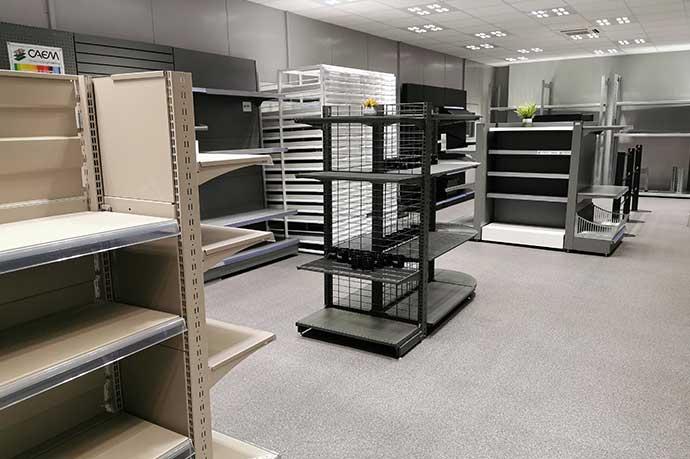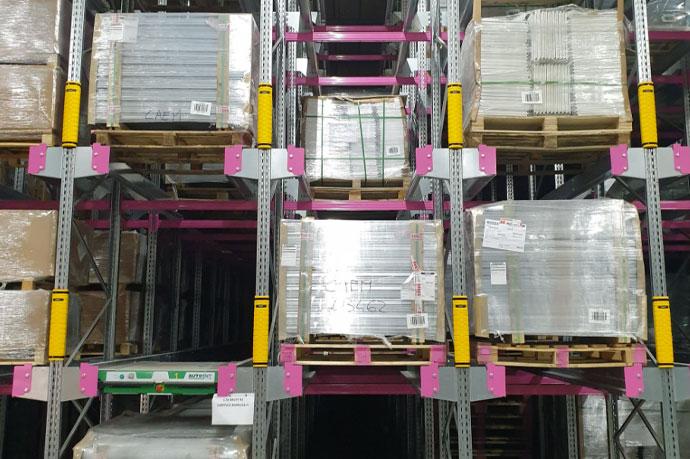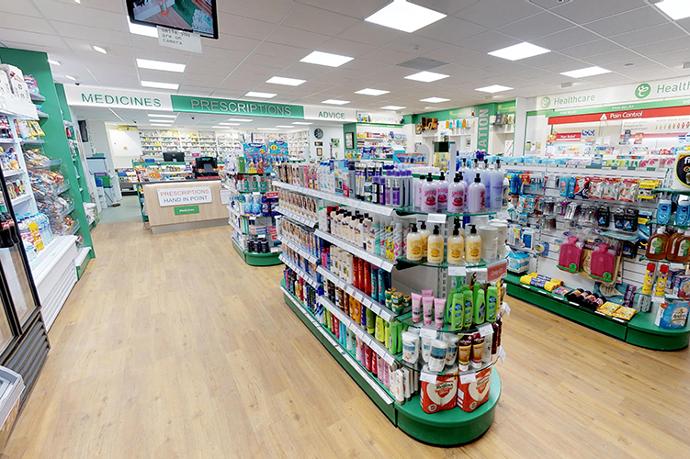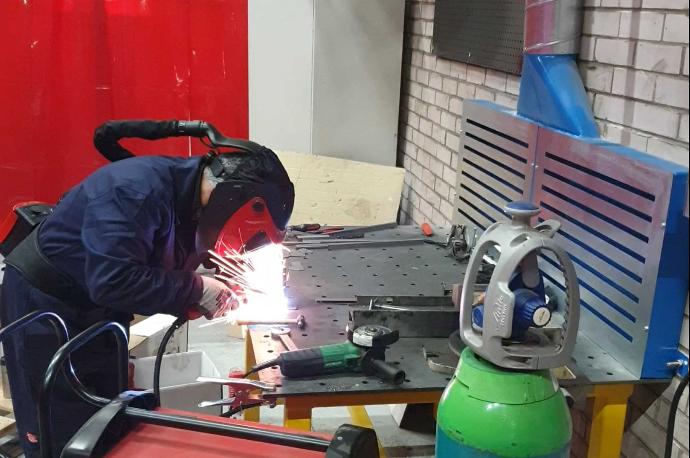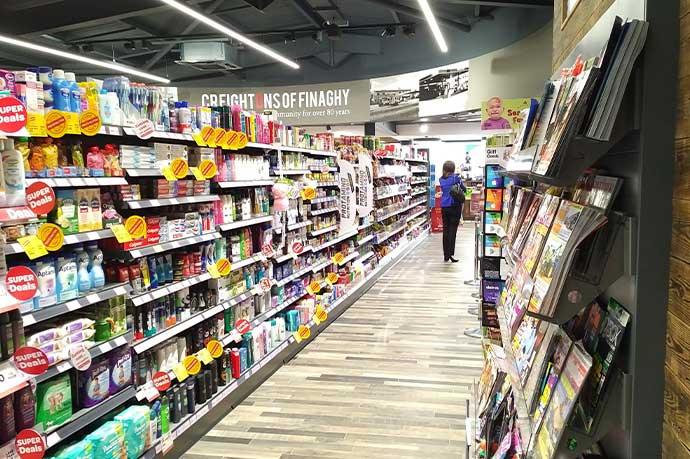Shop Fittings & Retail Shelving – UK Manufacturing
Retailers understand that every square metre of shop floor is valuable. The right combination of shop fittings, retail shelving, and storage racking transforms an empty space into a functional, inviting environment that supports both operational efficiency and brand identity. With decades of experience, CAEM has helped leading UK retailers unlock the full potential of their stores through expertly engineered modular shelving and bespoke shop fitting displays.
Understanding Shop Fittings, Retail Shelving, and Storage Racking
Definition and Roles in Retail Stores
Shop fittings encompass all fixtures, shelving, racks, and counters designed to display, store, and organise merchandise within a retail environment. Retail shelving refers to the modular units—like gondolas, wall bays, and display cabinets—that bring order and accessibility to the sales floor. Storage racking, by contrast, is engineered for the back-of-house or warehouse, prioritising bulk storage and efficient inventory management. Together, these elements form the backbone of a well-structured store, supporting merchandising strategies, replenishment, and customer experience.
Significance in Enhancing Store Efficiency and Aesthetics
A carefully planned shop fitting scheme does far more than house products; it sets the tone for the customer journey. Strategic use of retail shelving and shop racking maximises available space, ensures merchandise is presented attractively, and streamlines restocking. The impact of placement is significant—research shows that eye-level shelves can boost sales by up to 23%, while premium spots like endcaps drive even higher increases. Aesthetics—whether through finishes, colours, or lighting—reinforce brand identity and invite customers to explore. High-quality shop fittings also improve staff productivity and make day-to-day operations smoother, ultimately supporting sales growth and customer satisfaction.
Types of Retail Shelving Solutions
Gondola Shelving: Advantages and Use Cases
Gondola shelving is the stalwart of modern retail shop fittings. Its double-sided, free-standing design offers exceptional flexibility, allowing for both central aisle displays and wall layouts. Systems like CAEM's TN9, S50, and M25 are manufactured from robust steel, ensuring long-term durability and significant load capacity. Accessories such as end bays, hooks, and baskets can be added or reconfigured with ease, making gondolas ideal for supermarkets, pharmacies, and convenience stores. The ability to adapt quickly to seasonal changes or promotions is a particular strength, supporting both operational agility and visual merchandising goals.
Slatwall and Gridwall Systems: Versatility and Customisation
Slatwall and gridwall systems offer unparalleled versatility in retail shelving. With a range of interchangeable accessories—hooks, shelves, bins—these systems enable rapid adaptation to changing stock profiles or promotional campaigns. Both wall-mounted and free-standing options are available, supporting everything from fashion accessories to electronics. Customisation extends to finishes, panel sizes, and colourways, ensuring alignment with store branding and product needs.
Display Cabinets and Showcase Options
For high-value or premium products, secure display cabinets and showcases are essential. CAEM's modular drawer units, such as the D25 system for pharmacies, provide both protection and organisation, while glass and acrylic finishes maintain product visibility. Integrated lighting and custom branding features further enhance presentation, making these solutions ideal for jewellery, electronics, and healthcare environments where both security and aesthetics matter.
Wall Shelving vs Free-standing Shelves: Pros and Cons
Wall shelving maximises vertical space along the store perimeter, freeing up central areas for flexible merchandising. It is particularly suited to heavy or bulk goods, with robust construction to support higher loads. Free-standing shelves—like gondolas and island units—offer unmatched flexibility, enabling quick layout changes and easy access from multiple sides. The choice between the two depends on store size, product mix, and the need for agility versus load capacity.
Trending Material Choices for Retail Shelving
Metals such as steel and aluminium remain dominant in shop fittings due to their durability, versatility, and aesthetic appeal. Powder-coated finishes and custom colour options allow retailers to maintain brand consistency across locations. Meanwhile, wood accents, glass, and sustainable materials are increasingly popular for their warmth and environmental credentials, reflecting the growing emphasis on eco-friendly materials in retail shopfitting.
Choosing the Right Storage Racking Systems
Pallet Racking for Large Inventory Management
Pallet racking is the go-to solution for retailers with substantial inventory volumes. These heavy-duty systems accommodate large pallets and bulk goods, supporting fast replenishment and organised back-of-house storage. CAEM's IF50 system integrates high-level racking with shelving, maximising vertical space and providing robust support for heavy loads. Modular components and adjustable beams ensure compatibility with a wide range of inventory profiles.
Longspan Shelving for Medium-sized Merchandise
Longspan shelving bridges the gap between standard retail shelving and industrial pallet racking. Designed for medium-sized goods, boxed products, or bulkier items, systems like CAEM's LS9 offer high load-bearing capacity, modular assembly, and easy adjustability. This makes them ideal for storerooms, stockrooms, and fast-moving retail environments where flexibility and accessibility are paramount.
Modular Shelving Units: Flexibility and Adaptability
Retailers increasingly demand adaptable solutions that can grow and change with their business. CAEM's modular shelving—exemplified by the TN9 and S50 systems—features fully configurable uprights, a choice of back panels (perforated, slat, or wire), and a spectrum of colours via powder coating. These systems support both front-of-house display and backroom storage, offering continuity and efficiency across all areas of a retail operation.
Material Considerations: Steel, Aluminium, and Beyond
Steel remains the material of choice for most shop racking and retail shelving, prized for its strength and longevity. Aluminium provides a lightweight, corrosion-resistant alternative, particularly suited to specialist or outdoor environments. Hybrid constructions—combining steel frames with wood or glass accents—blend practicality with design appeal, while sustainable materials are on the rise as part of a broader push for eco-friendly retail shopfitting.
Best Practices in Shop Fittings and Layout Design
Shop Fitting Techniques to Enhance Customer Experience
Every element of shop fitting impacts how customers perceive and navigate a store. Strategic placement of shelving and displays guides foot traffic, highlights key merchandise, and encourages exploration. Height, accessibility, and colour coordination all contribute to a positive experience. The integration of LED lighting, digital signage, and interactive displays adds another dimension, drawing attention to featured products and supporting impulse purchases.
Optimising Retail Space with Strategic Layout Planning
Effective store layout is both art and science. Zoning related products, analysing traffic flow, and positioning high-margin goods at focal points can significantly influence sales. Modular shelving systems—like CAEM's M25, with its ultra-low base and central back panel—help retailers maximise product facings and create wider aisles for smoother customer movement. The ability to reconfigure layouts quickly keeps stores fresh and responsive to changing trends.
Decision-Making Framework for Shelving Selection
When evaluating shelving needs, retailers should consider several key factors. First, assess your product mix and weight requirements to determine load-bearing needs. Consider foot traffic patterns and customer height demographics when planning shelf placement. Budget constraints and future expansion plans should guide decisions between fixed and modular systems. Maintenance requirements, staff accessibility for restocking, and compliance with safety standards must also factor into the selection process. Document these requirements clearly before approaching suppliers to ensure you receive tailored recommendations.
Common Mistakes to Avoid in Shop Fitting
Retailers often underestimate the importance of proper planning, leading to layouts that restrict movement or create blind spots. Choosing systems purely on price without considering long-term flexibility can result in costly replacements when business needs change. Neglecting safety requirements or attempting DIY installation of complex systems poses serious risks. Failing to consider maintenance accessibility during design can create ongoing operational challenges. Another frequent oversight is ignoring brand consistency across multiple locations, which weakens overall brand identity.
Safe Installation Guidelines and Compliance Standards
Safety is non-negotiable in retail shopfitting. Current UK regulations require adherence to specific standards for shelving installation. HSG76 stipulates that racking should be installed on sound, level floors capable of withstanding point loading, and installation should only be carried out by competent individuals following manufacturer instructions.
For retail environments, shelving units with a height-to-depth ratio exceeding 4:1 must be secured to the floor. CAEM recommends professional installation for all shelving systems, with wall fixing required for uprights over 200cm to maintain safe weight loadings. A three-step levelling process ensures stability, and all installations must comply with the Product Safety and Metrology etc. (Amendment) Regulations 2024.
Businesses must nominate a Person Responsible for Racking Safety (PRRS) who ensures regular monthly visual inspections are conducted, maintains written records, and ensures maximum load capacities are never exceeded.
Maintenance Tips to Prolong the Life of Shop Fittings
Routine cleaning, daily checks, and periodic inspections are vital for prolonging the lifespan of shop fittings. Issues such as misaligned brackets, bent shelves, or disengaged panels should be addressed promptly. Following the manufacturer's maintenance manual, using suitable cleaning products, and keeping records of all checks not only ensure safety but also support warranty claims and compliance. Monthly visual inspections for damage must be documented, with proper identification and immediate action on any issues discovered.
The Future of Retail Shelving and Storage Racking
Market Growth and Investment Trends
The retail shelving industry continues to experience significant growth, with the retail shelving system market valued at USD 18.36 billion in 2023 and projected to reach USD 27.3 billion by 2032. This demonstrates increasing retailer investment in effective shelving solutions. The retail smart shelf market is estimated at $2.5 billion in 2025 and projected to grow at a CAGR of 15%, indicating strong adoption of technology-enhanced shelving systems.
Innovative Technologies Enhancing Retail Displays
Retail shelving is evolving rapidly, driven by technology and changing consumer expectations. Smart shelves equipped with IoT sensors and RFID enable real-time inventory tracking and automated stock alerts. Major retailers are making substantial investments in this technology—Walmart announced the extension of electronic shelf pricing to an additional 500 stores in May 2023, implementing approximately 60 million shelf labels over an 18-month period.
Modular LED lighting, like CAEM's Ardente system, enhances product visibility and can be retrofitted to existing metal shelving. Cloud-managed digital signage and interactive screens personalise the shopping experience, while mobile and reconfigurable shelving support pop-up and experiential retail formats.
Sustainable Shop Fitting Solutions
Sustainability is now a core consideration in shop fitting design. Retailers are adopting eco-friendly materials such as recycled metals, certified woods, and low-emission finishes. Modular, reusable systems reduce waste during store renovations or relocations, and green manufacturing practices—including energy-efficient production and reduced packaging—are increasingly standard. Lifecycle planning, including end-of-use recycling or refurbishment, is becoming an integral part of product selection.
The Role of Data-driven Design in Retail Environments
Data analytics are reshaping how retailers plan layouts and configure shelving. Heat mapping and customer flow analysis inform the placement of high-demand or promotional items. Inventory management systems now integrate directly with shelving, automating restocking and minimising out-of-stocks. Smart shelves with IoT and AI capabilities provide real-time inventory monitoring, predictive analytics, and support for personalised promotions, leading to reduced stockouts and optimised ordering processes.
Budget Considerations for Retail Shelving Projects
Shelving investments vary significantly based on system complexity, materials, and customisation requirements. Basic gondola systems typically offer the most cost-effective option for standard retail environments, while specialised display cases command premium pricing. Consider total cost of ownership, including installation, maintenance, and potential reconfiguration needs. Modular systems may have higher upfront costs but provide long-term value through adaptability and reusability. Factor in compliance requirements, safety standards, and professional installation costs when budgeting for shelving projects.
For more than 30 years, CAEM has been at the forefront of UK shop fittings, retail shelving, and storage racking innovation. With a commitment to quality, adaptability, and service, CAEM continues to support retailers in building future-proof, high-performing store environments that delight customers and drive business growth.
